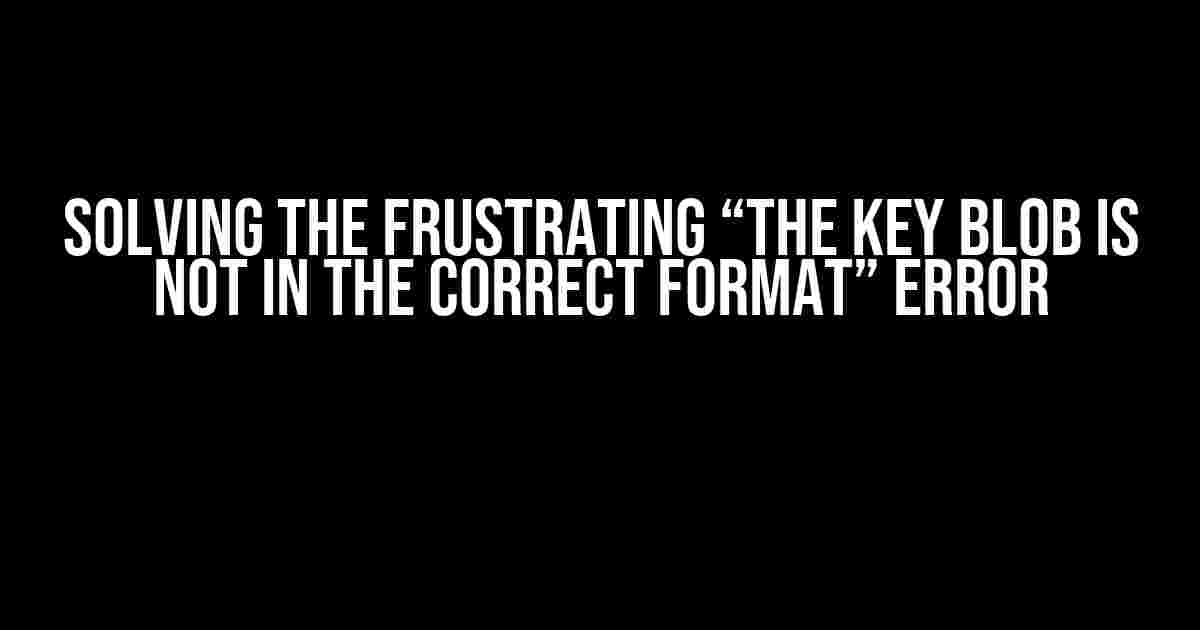What is a BLOB and Why Does it Matter?
Before we dive into the solution, it’s essential to understand what a BLOB is and its significance in the realm of database management.
A BLOB (Binary Large OBject) is a data type used to store large amounts of binary data, such as images, audio files, and videos, in a database. In the context of Azure Key Vault, a BLOB is used to store cryptographic keys.
The Culprit: “The key BLOB is not in the correct format” Error
Imagine this: you’re working on a project, and everything seems to be going smoothly. You’ve set up your Azure Key Vault, generated a key, and stored it in a BLOB. But, when you try to use the key, you’re met with the frustrating error message: “The key BLOB is not in the correct format”.
This error can occur due to various reasons, including:
- Incorrect formatting of the BLOB
- Corrupted data during transmission or storage
- Incompatible data types or encoding
- Authentication or authorization issues
Solution: Troubleshooting and Resolution
Don’t worry; we’ve got you covered! Let’s break down the steps to troubleshoot and resolve the “The key BLOB is not in the correct format” error.
Step 1: Verify the BLOB Format
The first step is to ensure that the BLOB is in the correct format. Azure Key Vault expects the BLOB to be in a specific format, which includes:
{
"k": [byte array of key],
"kt": "RSA" or "RSA-HSM",
"keyOps": ["encrypt", "decrypt"],
"n": [byte array of modulus],
"e": [byte array of public exponent]
}
Make sure your BLOB conforms to this format. If you’re generating the key using a third-party tool or library, ensure that it’s producing a compliant BLOB.
Step 2: Check Data Encoding and Compression
Verify that the BLOB is encoded and compressed correctly. Azure Key Vault expects the BLOB to be encoded in Base64 and compressed using Gzip.
Here’s an example of how you can encode and compress the BLOB using Python:
import base64 import gzip # Assume 'key_data' is the byte array of the key # Encode the key data in Base64 encoded_key = base64.b64encode(key_data) # Compress the encoded key using Gzip compressed_key = gzip.compress(encoded_key) # Store the compressed key in the BLOB blob = compressed_key
Step 3: Verify Authentication and Authorization
Ensure that you’re authenticated and authorized to access the Azure Key Vault. Check that you have the necessary permissions and credentials to perform operations on the key.
You can use the Azure CLI or Azure SDKs to authenticate and authorize your requests. Here’s an example of how you can authenticate using the Azure CLI:
az keyvault set-policy --name--resource-group --object-id --key-permissions get
Step 4: Review Key Vault Configuration
Verify that your Azure Key Vault is configured correctly. Check the following:
- Key Vault name and resource group
- Access policies and permissions
- Key type and algorithms
Ensure that the Key Vault is enabled for the correct key type and algorithms. You can use the Azure CLI or Azure SDKs to verify the Key Vault configuration.
Best Practices to Avoid the “The key BLOB is not in the correct format” Error
To avoid encountering the “The key BLOB is not in the correct format” error in the future, follow these best practices:
- Use the Azure Key Vault SDKs: Leverage the Azure Key Vault SDKs to generate and store keys. These SDKs ensure that the BLOB is formatted correctly and comply with Azure Key Vault requirements.
- Verify BLOB Format: Always verify the BLOB format before storing it in Azure Key Vault.
- Use Secure Encoding and Compression: Ensure that you’re using secure encoding (Base64) and compression (Gzip) algorithms to protect your key data.
- Test and Validate: Thoroughly test and validate your code and configurations to ensure that they’re working as expected.
- Monitor and Log: Implement monitoring and logging mechanisms to detect and troubleshoot issues promptly.
Conclusion
The “The key BLOB is not in the correct format” error can be frustrating, but with the right guidance, you can troubleshoot and resolve it efficiently. By following the steps outlined in this article, you’ll be able to identify and fix the root cause of the issue, ensuring that your Azure Key Vault and cryptographic keys are functioning correctly.
Remember to always follow best practices to avoid encountering this error in the future. If you have any further questions or concerns, feel free to ask!
| Tip | Description |
|---|---|
| Use Azure Key Vault SDKs | Leverage Azure Key Vault SDKs to generate and store keys. |
| Verify BLOB Format | Always verify the BLOB format before storing it in Azure Key Vault. |
| Use Secure Encoding and Compression | Ensure that you’re using secure encoding (Base64) and compression (Gzip) algorithms. |
Frequently Asked Question
Are you stuck with the annoying “The key BLOB is not in the correct format” error? Don’t worry, we’ve got you covered!
What does “The key BLOB is not in the correct format” error mean?
This error typically occurs when trying to import a cryptographic key, and the key’s format doesn’t match the expected format. This could be due to a mismatch between the key’s format and the expected format, or even a corrupted key.
Why does the key BLOB need to be in a specific format?
Keys need to be in a specific format so that they can be correctly interpreted and used by the cryptographic algorithm. Think of it like a special language that only the algorithm can understand. If the key is not in the correct format, the algorithm gets confused and throws an error.
How can I fix the “The key BLOB is not in the correct format” error?
To fix this error, you’ll need to check the key’s format and make sure it matches the expected format. You might need to re-generate the key or convert it to the correct format using a tool or code snippet. If you’re still stuck, try searching online for specific guidance related to your programming language or framework.
Can I prevent “The key BLOB is not in the correct format” errors in the future?
Yes! To prevent this error from occurring again, make sure to carefully follow the guidelines for generating and handling cryptographic keys. Use trusted libraries and frameworks, and double-check the key’s format before using it. Also, consider using automated tools to validate and convert key formats to ensure they’re correct.
What are the consequences of ignoring “The key BLOB is not in the correct format” errors?
Ignoring this error can lead to serious security vulnerabilities, as misformatted keys can compromise the encryption and decryption process. This can put sensitive data at risk of being accessed or tampered with by unauthorized parties. Don’t ignore the error – take the time to fix it and ensure your app’s security!



